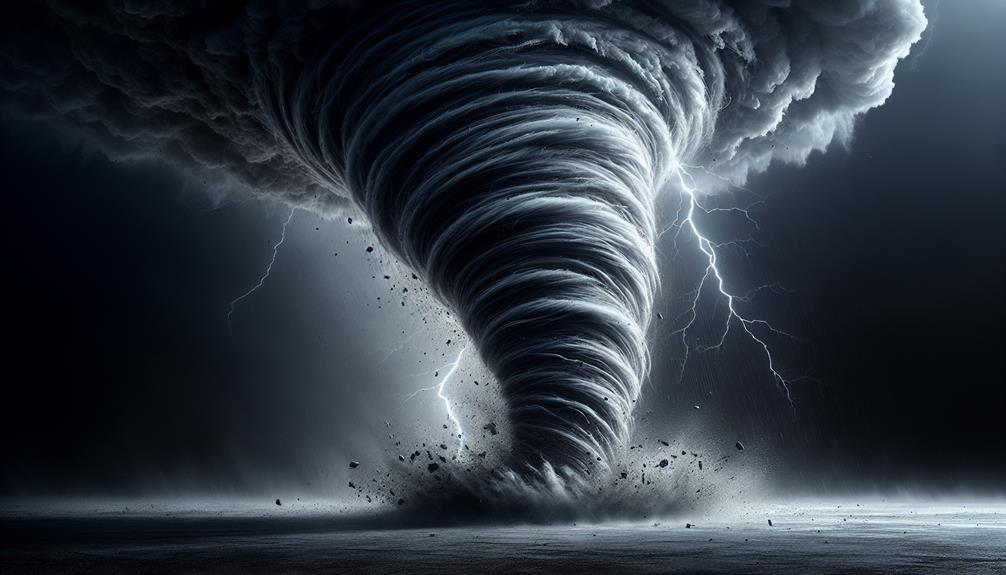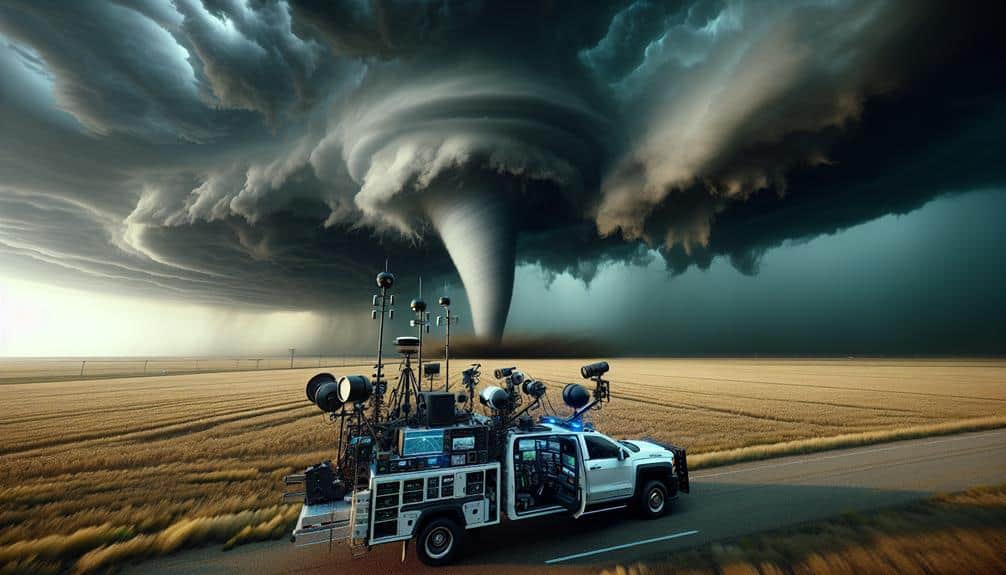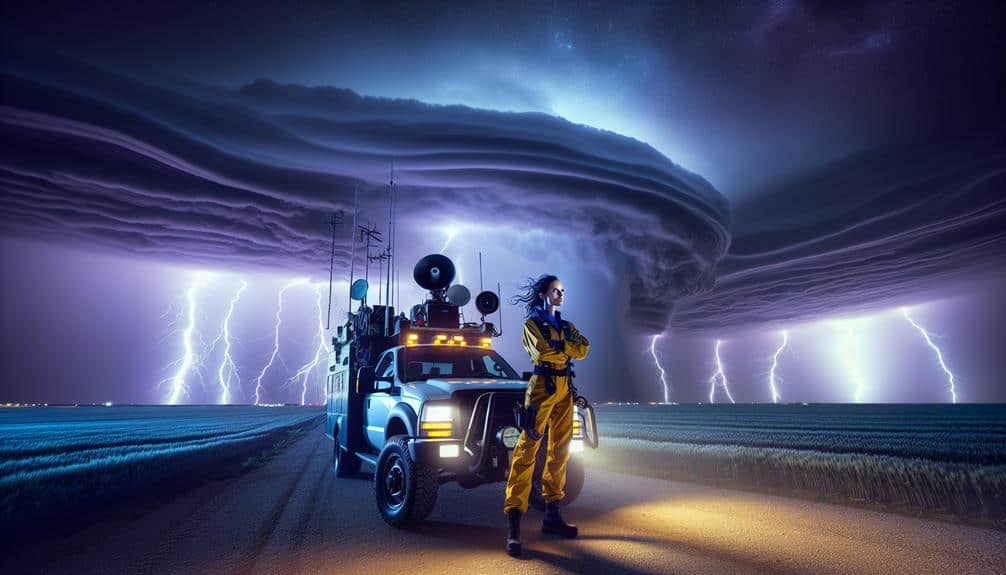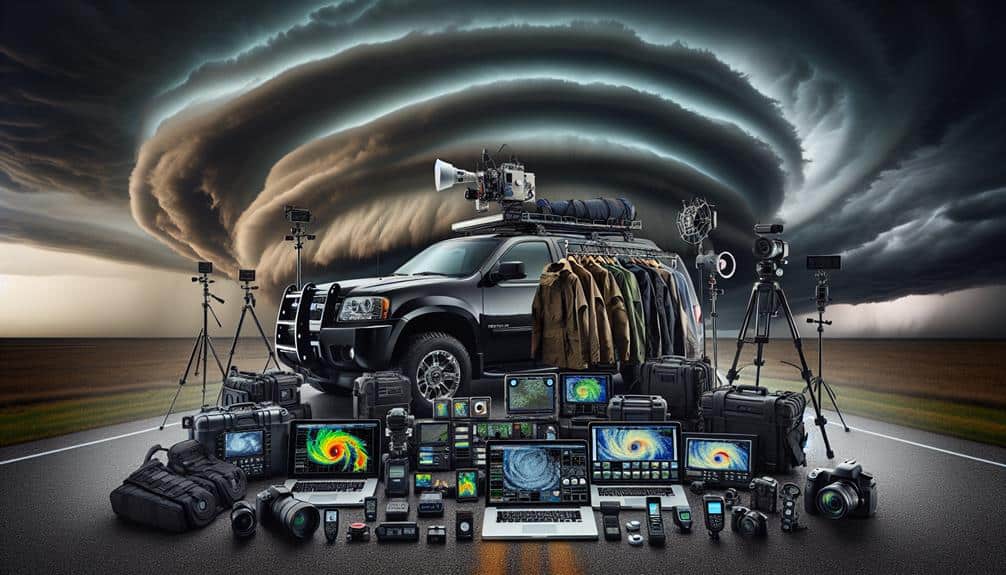Documenting tornadoes up close is essential for advancing meteorological research and enhancing early warning systems. By capturing precise data through advanced technologies like high-resolution radar and drones, we gain valuable insights into tornado dynamics. This data refines our predictive models, leading to more accurate and timely alerts that improve public safety. Observing rare atmospheric behaviors during tornadoes also helps identify patterns and anomalies, further enriching our understanding. Additionally, thorough data collection supports disaster response and long-term infrastructure planning. For those interested in the detailed intricacies and broader impact of this research, there's much more to uncover.
Key Points
- Documenting tornadoes up close advances meteorological research by providing real-world data for analysis.
- Up-close observations improve early warning systems, leading to timely and accurate alerts.
- Detailed data collection from tornadoes refines predictive models and enhances forecasting accuracy.
- Understanding tornado dynamics through close documentation aids in public safety and emergency preparedness.
Advancing Meteorological Research
By closely documenting tornadoes, we can greatly advance meteorological research and improve our understanding of these powerful natural phenomena. Our commitment to capturing detailed field observations and conducting rigorous data analysis is pivotal. These efforts lead to scientific breakthroughs that deepen our comprehension of tornado dynamics and behavior.
Technological innovations play a vital role in this endeavor. High-resolution radar systems, drones, and specialized sensors allow us to gather precise data from within and around tornadoes. This data isn't just numbers; it's the key to revealing patterns and trends that were previously concealed. By analyzing this information, we can identify the variables that contribute to tornado formation and intensity, which is essential for enhancing predictive models.
Moreover, our field observations provide invaluable real-world insights that laboratory simulations can't replicate. The direct observation of tornadoes in diverse geographical and meteorological conditions helps us refine our theories and improve the accuracy of our forecasts.
We're not just collecting data for the sake of it; each piece of information adds a layer of understanding that fuels further research and innovation. Together, these efforts empower us to push the boundaries of meteorological science and gain a greater degree of freedom in predicting and understanding tornadoes.
Enhancing Early Warning Systems
Leveraging our extensive research, we can greatly improve early warning systems to provide more precise and timely alerts for communities at risk of tornadoes. By integrating advanced technology, such as high-resolution radar and real-time data collection tools, we enhance forecasting and data accuracy. This integration allows meteorologists to pinpoint the development and trajectory of tornadoes with greater precision, ultimately leading to more dependable warnings.
In addition to technology integration, community engagement plays an essential role in the success of early warning systems. By working closely with local communities, we can guarantee that residents are educated about tornado risks and know how to respond when alerts are issued. Tailored outreach programs and emergency drills help foster a culture of preparedness, improving the overall effectiveness of the warning systems.
Moreover, the data we gather from up-close documentation of tornadoes enables us to refine predictive models. These models become increasingly precise as they incorporate detailed observations, leading to earlier and more accurate alerts. Consequently, communities gain more time to take protective measures, thereby reducing the potential for loss of life and property.
Through these combined efforts, we empower individuals and enhance their ability to act decisively in the face of tornado threats.
Providing Valuable Data
Our meticulous recording of tornadoes yields invaluable information that enhances our comprehension of these powerful natural occurrences. By gathering precise measurements and observations, we enable scientific analysis that delves into the complexities of tornado formation, behavior, and impact. This data collection is essential for advancing meteorological models and theories.
When we're in the field, every piece of data we collect—whether it's wind speed, pressure changes, or structural damage—contributes to a growing repository of knowledge. This detailed information allows scientists to identify patterns and anomalies, refining their hypotheses and improving predictive models. As we analyze this wealth of data, we start to uncover the underlying mechanisms that propel tornado dynamics.
Our efforts in data collection don't just stop at surface-level observations. We utilize advanced technology like Doppler radar, drones, and high-resolution cameras to capture every detail of a tornado's lifecycle. This multifaceted approach provides a thorough dataset, facilitating a more nuanced scientific analysis.
In essence, our dedication to documenting tornadoes up close is about pushing the boundaries of what we understand, giving us the freedom to better comprehend and, ultimately, coexist with these formidable forces of nature.
Promoting Public Safety
Understanding tornadoes in great detail not only enhances our scientific knowledge but also plays an essential role in promoting public safety. When we document tornadoes up close, we gather vital data that can be used to improve emergency preparedness. This information helps meteorologists predict tornado paths more accurately, allowing for timely warnings that can save lives.
By educating communities on the nature of tornadoes and the significance of these warnings, we can foster a culture of readiness and resilience.
In addition to community education, detailed tornado documentation is indispensable for effective disaster response. First responders and emergency managers use this data to develop and refine risk mitigation strategies. By understanding the specific conditions under which tornadoes form and intensify, we can better allocate resources and plan evacuations, minimizing the impact on affected populations.
Moreover, the data we collect enables us to identify patterns and trends, which can inform long-term planning and infrastructure improvements. This proactive approach guarantees that our communities aren't only prepared for immediate threats but also more robust in the face of future tornadoes.
Ultimately, our efforts in documenting tornadoes up close empower us to protect lives and promote public safety.
Capturing Rare Phenomena

Capturing rare events during tornadoes allows us to observe and analyze unique atmospheric behaviors that are important for advancing our understanding of these powerful storms. When we document tornadoes up close, we gain insights into the mechanics of extreme weather events. This information is vital for developing predictive models that can save lives and minimize damage.
By focusing on the intricate details of a tornado's formation and progression, we can identify patterns and anomalies that might otherwise remain unnoticed. For instance, the sudden appearance of multiple vortices within a single tornado or the unexpected shifts in wind direction and speed are aspects of natural disasters that we can only comprehend through direct observation. These rare events provide valuable data that enhance our predictive capabilities and improve our response strategies.
Moreover, understanding these unique behaviors helps us refine the way we communicate risks to the public. By sharing precise and accurate information about potential threats, we empower individuals to make informed decisions and maintain their freedom even in the face of extreme weather. Our commitment to capturing these rare moments ensures that we continue to build a resilient and informed society.
Frequently Asked Questions
How Do Storm Chasers Stay Safe While Documenting Tornadoes?
We stay safe while documenting tornadoes by following strict safety precautions and leveraging technology advancements like GPS tracking, radar, and communication tools. These measures allow us to maintain situational awareness and make informed decisions in real-time.
What Equipment Is Essential for Photographing Tornadoes up Close?
We absolutely need the world's best camera settings, protective gear, and communication devices. Ensuring safety precautions is essential, as it allows us to capture breathtaking tornado shots up close while staying protected and connected with our team.
Can Documenting Tornadoes Help in Understanding Their Seasonal Patterns?
By documenting tornadoes, we enhance seasonal analysis and contribute to meteorological research. This data helps us understand patterns, predict occurrences, and potentially mitigate damage, offering us greater freedom from the unpredictability of these natural phenomena.
How Do Researchers Choose Which Tornadoes to Document?
We base tornado selection on strict research criteria, prioritizing those with significant potential for data collection. Tornado tracking involves analyzing weather patterns to guarantee precise documentation, maximizing our understanding of these powerful natural phenomena.
What Are Some Common Challenges Faced When Documenting Tornadoes?
Documenting tornadoes is like maneuvering through a turbulent storm; weather patterns and obstacles constantly shift. We face immense challenges ensuring safety precautions and maintaining clear communication amidst chaos, all while capturing precise data for future freedom from storm dangers.


